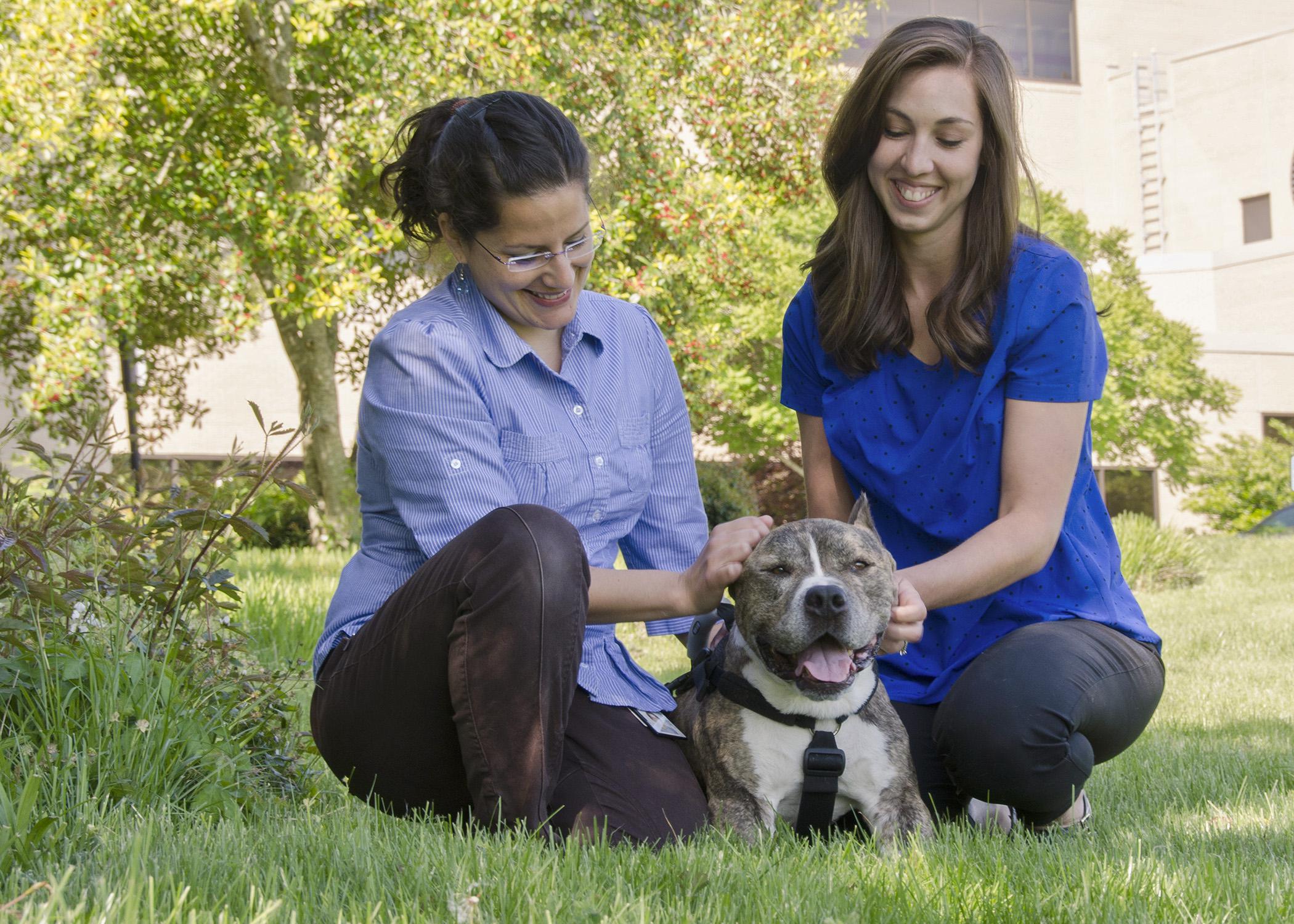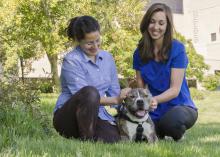Information Possibly Outdated
The information presented on this page was originally released on July 29, 2014. It may not be outdated, but please search our site for more current information. If you plan to quote or reference this information in a publication, please check with the Extension specialist or author before proceeding.
MSU team work, care gets dog back on his feet
By Karen Templeton
MSU College of Veterinary Medicine
MISSISSIPPI STATE -- When John and Paula Cormane took their dog to the Mississippi State University College of Veterinary Medicine, they could only hope he would be able to walk back out the same doors they carried him through.
A month earlier, Dirty, a 13-year-old pit bull, had begun walking very unsteadily. Soon, he was falling over and unable to stand. His owners, residents of Alexandria, Louisiana, took him to their local veterinarian, who then referred them to the Louisiana State University School of Veterinary Medicine.
“They were great at LSU, and it was clear they worked well with the veterinarians at Mississippi State,” said Paula Cormane. “They could give Dirty great care and were able to determine he had Wobbler’s syndrome, but they said they didn’t perform the surgery needed to correct it. They said Dr. Andy Shores and his team at MSU could handle it.”
The Cormanes drove to Starkville, Mississippi and met with Dr. Shores, head of neurology/neurosurgery at the MSU College of Veterinary Medicine, and his team.
“Wobbler’s syndrome is a neurological condition that is basically the instability of the cervical vertebrae. This causes an unsteady gait, and with progression, results in the dog not being able to walk,” Shores said. “Dirty’s condition was pretty severe with many chronic changes. We took pressure off his spinal cord over the span of three of his cervical vertebrae during the two-and-a-half hour surgery to give him relief.”
The surgery, performed at the college’s Animal Health Center, was the first step in getting Dirty back on his feet. Dirty then embarked on a lengthy rehabilitation program.
Dr. Maria Perez-Hernandez, neurology/neurosurgery veterinary resident, met Dirty just three weeks after his surgery. Her role was to monitor and adjust his physical therapy, oversee his medications and prevent complications from his immobility.
“This was a team effort from the start,” Perez-Hernandez said. “Dr. Simon Kornberg, also a resident, was primarily involved in the surgery and got Dirty started in his recovery, and then I worked closely with the students and the rehabilitation service to make sure he was getting the best quality of care.”
Dr. Perez-Hernandez, who is also certified in small animal rehabilitation, knew the case would be tough because in addition to the surgical recovery, Dirty was dealing with severe arthritis in his front limbs. She saw Dirty almost daily and even worked on weekends to get him rehabilitated.
“We made sure he was really comfortable in his environment and that he was getting proper nutrition,” Perez-Hernandez said. “It was clear after his surgery that he was a little depressed. We encouraged him through lots of interaction with the students and clinicians on the case.”
Ruby Lynn Carter, a veterinary technician certified in small animal physical rehabilitation, worked with the team to give Dirty a comprehensive rehabilitation regimen.
“Because Dirty had been off of his feet so long, we had to start him from basically nothing,” Carter said. “We put him in the infinity pool and could barely get him to move, but we didn’t give up. We continued to get him in the pool where he didn’t have to fight gravity and also in the quad cart. It was a long process, and it took quite some time to see any progress.”
One day while Dirty was on the aquatic treadmill, the team finally saw some movement.
The aquatic treadmill relieves stress on a dog’s joints, allowing the animal to move more freely. Dirty caught on and started to move his legs a few months into his treatment.
“We would start to put food in front of him while on the treadmill and in the cart and slowly, he started to move forward,” Carter said. “We were then able to take him for walks using a harness and help him learn to shift weight again using a therapy ball.”
The Cormanes were pleased with his progress, and their hope started to turn into reality.
“We would hear from the students involved in the case daily,” Cormane said. “They allowed us to talk to him on the phone and would share all the notes on his progress. It was helpful and encouraging.”
Five months after his surgery, as veterinary clinicians, residents, veterinary technicians and students lined the Animal Health Center hallway, Dirty took his first steps on his own.
“It was quite the scene, and there was barely a dry eye left in the house,” Carter said. “A total of almost 40 students worked with Dirty as they completed their rotations. He really became a part of our MSU-CVM family.”
The Cormanes returned to Starkville to take Dirty home and were thrilled that he could walk out the door.
“We are so happy with the care he received, but it was so good to bring him home,” Cormane said. “It was pretty heart-wrenching when he turned to look over his shoulder at Lauren, one of the students he spent a lot of time with. I could tell there was a bond.”
Perez-Hernandez, who has been practicing veterinary rehabilitation for seven years, will remember Dirty as one of her toughest but most rewarding cases.
“He has provided all of us on the team with an exceptional learning experience,” she said. “He left not only with the ability to walk, but also a little bit of each of our hearts. We are so fortunate to have learned from him.”
Contact: Karen Templeton, 662-325-1100




